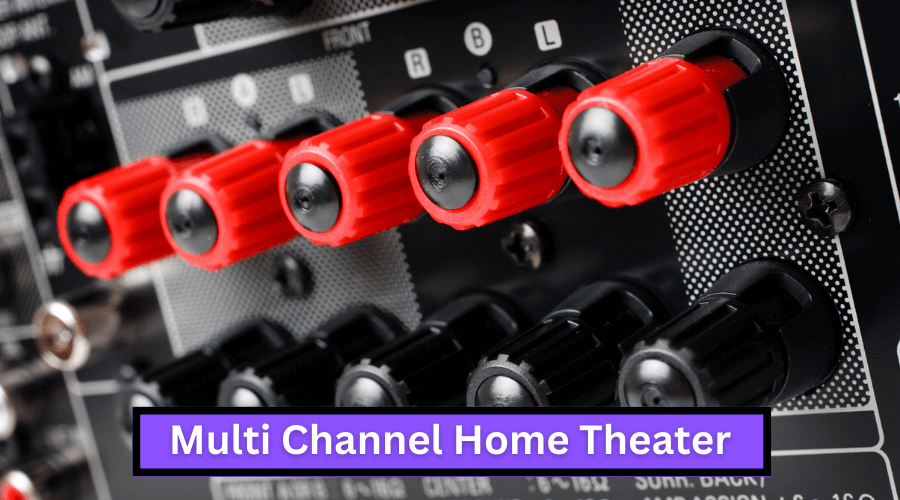Multichannel home Theater is home entertainment that includes multiple audio channels for surround sound.
It aims to provide an immersive audio experience by creating a sense of space and directional cues for the viewer. This is achieved using multiple speakers around the room, each playing a different audio channel.
A typical multi-channel home theater combines the front left and right speakers, a center channel speaker, surround left and right speakers, and one or more subwoofers.
The front left, and right speakers are typically placed at the front of the room and produce most of the sound, while the center channel speaker is placed directly in front of the viewer and enhances dialogue and other vocal elements.
What is the Multi-Channel Home Theater?
A multi-channel home theater is a type of home entertainment. It uses multiple audio channels to create a surround sound experience.
The home theater aims to provide an immersive audio experience by creating a sense of space and directional cues for the listener.
A typical multi-channel home theater comprises front, left, and right speakers. A center channel speaker, surround left and right speakers, and a subwoofer.
The center channel speaker is placed in front of the listener, enhancing dialogue and other vocal elements.
When set up correctly, a home theater can provide an immersive audio experience. It makes you feel like you are part of the action on the screen.
To get the best experience, it is essential to choose high-quality speakers and other components and calibrate them to your room correctly.
Types of Multi-Channel Home Theater Systems
There are several different types of multi-channel home theaters. Which can vary in terms of the number of audio channels. The type of speakers used and the overall design. Some common types of multi-channel home theaters include:
1. 5.1 Channel System
A 5.1-channel is the most common type of multi-channel home theater. It comprises five main speakers (left, center, right, left, and right surround) and one subwoofer. This provides a basic surround sound experience and is a good starting point for most people.
2. 7.1 Channel System
A 7.1-channel system is similar to a 5.1-channel system, but it includes two additional surround speakers (left back and right back) to provide a more immersive surround sound experience.
3. 9.1 Channel System
A 9.1 channel is the latest and most advanced. Type of multi-channel home theater includes nine main speakers (left, center, right, left front height, right front height, left surround, right surround, left back, and right back) and one subwoofer. This provides a highly immersive surround sound experience.
4. Dolby Atmos and DTS:X Systems
Dolby Atmos and DTS:X are advanced surround sound technologies. It adds height channels to the traditional 5.1 or 7.1 channels, allowing sounds to be placed and moved in a three-dimensional space for a more realistic and immersive experience.
5. Wireless Multi-Channel Systems
Wireless multi-channels use wireless technology to connect the speakers, eliminating the need for speaker wires and making setup easier. Some popular brands for wireless multi-channel s include Sonos and Bose.
Your multi-channel home theater type will depend on your budget, room size, and personal preferences. Before deciding, it’s essential to consider the size of your room, the placement of your speakers, and the type of content you will be watching.
Basic Terminology of Multi-Channel Home Theater
Several key terms are used in the world of multi-channel home theaters. Understanding these terms can help you choose the right and set it up correctly:
1. Audio Channel
An audio channel is a separate stream corresponding to a specific speaker in the. Each audio channel is responsible for reproducing a specific sound, such as dialogue, music, or sound effects, in a multi-channel home theater.
2. Surround Sound
Surround sound refers to a type of audio experience. It uses multiple audio channels to create a sense of space and directional cues for the listener.
In a multi-channel home theater, the surround sound experience is created by having speakers placed at different points in the room. Software manipulation of the audio creates a sense of direction and movement.
3. Subwoofer
A subwoofer is a speaker designed to reproduce low-frequency sounds, like bass and drums, in a multi-channel home theater. The subwoofer reproduces the low-frequency sounds that the main speakers cannot accurately reproduce.
4. Center Channel
The center channel is a speaker. It is placed in front of the listener and reproduces dialogue and other vocal elements. The center channel is an integral part of a home theater. Because it helps to ensure that the audio is clear and easy to understand.
5. Surround Speakers
Surround speakers are placed at the sides or rear of the room and are responsible for reproducing sounds.
It seems to come from behind the listener. The surround speakers play a crucial role in creating a surround sound experience and help to develop a sense of immersion and direction.
6. Frequency Response
Frequency response refers to the range of frequencies a speaker can accurately reproduce. In a multi-channel home theater.
It is essential to choose speakers with wide-frequency responses so that they can accurately reproduce the entire audio spectrum.
7. Calibration
Calibration is the process of adjusting the settings of a home theater. So that it sounds best in a specific room.
It typically involves adjusting the volume and placement of the speakers. I also adjusted other settings for room size, furniture placement, and other factors.
What Are the Advantages of Having a Multi-Channel Home Theater?
1. Enhanced Sound Experience
A multi-channel home theater provides an immersive and highly detailed sound experience. It has separate audio channels for different sounds and a dedicated subwoofer for low-frequency sounds, creating a more dynamic and engaging audio experience than a traditional stereo.
2. Surround Sound
Home theaters use surround sound to create a sense of space and directionality. This makes it feel like you are in the middle of the action rather than simply listening to audio from a single source.
3. Increased Clarity
The center channel speaker in a multi-channel home theater helps to improve the clarity of dialogue. Making it easier to understand speech in movies and TV shows. This is especially important for those who have trouble hearing dialogue. And who wants to enjoy audio without having to adjust the volume constantly?
4. Increased Volume
Multi-channel home theaters have a higher overall volume capability than traditional stereos, allowing you to enjoy audio at higher levels without losing quality.
5. More Dynamic Range
Multi-channel home theaters have a more extensive dynamic range than stereos, allowing you to enjoy a broader range of sounds, from whispers to explosive action scenes.
6. More Versatile
Multi-channel home theaters can be used for various applications, including watching movies, playing video games, listening to music, and even home theater surround sound.
7. Improved Home Aesthetics
Multi-channel home theaters can also enhance the look and feel of your home. Many s are designed to be stylish and discreet, fitting seamlessly into your decor.
8. Cost Effective
While multi-channel home theaters can be an investment, they can also be cost-effective in the long run. You don’t have to purchase separate components for different audio needs.
You can enjoy high-quality audio from a single. If you want more information on the topic, stay with the Online Demand.
What Are the Disadvantages of having a Multi-Channel Home Theater?
While there are many benefits to having a multi-channel home theater , there are also some downsides to consider, including:
1. Cost
Multi-channel home theater s can be expensive, especially if you want high-end components and many speakers.
2. Complex Installation
Installing a multi-channel home theater can be complex and time-consuming. Especially if you are not familiar with audio and home theater s.
3. Space Requirements
These s often require a large amount of space to accommodate. All the components and speakers may not be feasible for smaller homes or apartments.
4. Calibration
A home theater requires careful calibration to ensure optimal performance. This can be a challenging and time-consuming task, especially for those who are not familiar with audio s.
5. Maintenance
Its s require regular maintenance to keep them in good working order, including cleaning and checking. The connections between components and speakers.
6. Compatibility Issues
Not all audio and video content is compatible with multi-channel home theater s. And some content may not produce the desired surround sound effect.
7. Limited Portability
Its s are not portable. So, you cannot enjoy your audio and video content in different rooms or outside.
8. Interference
Multi-channel home Theaters can experience interference from other electronic devices, such as wireless networks and cell phones, which can affect audio quality.

